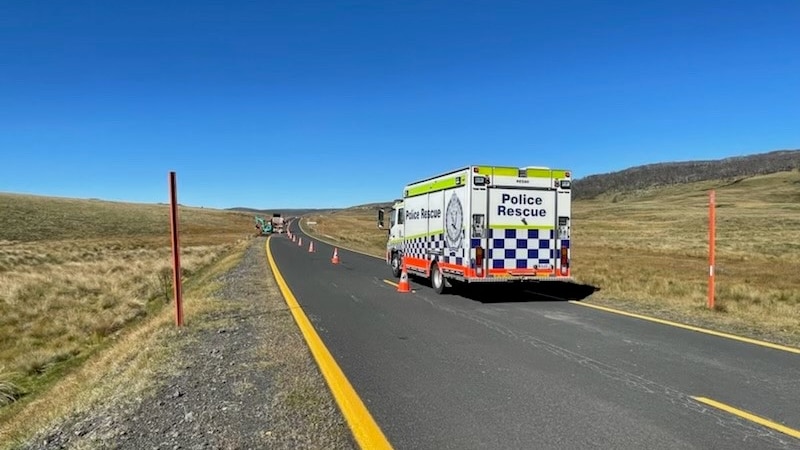An initial search to find a helicopter that later crashed in the New South Wales Snowy Mountains was called off after the pilot made contact with authorities, a preliminary report has been found.
Key points:
- A preliminary report into a fatal helicopter crash in the NSW Snowy Mountains has been released
- The helicopter, piloted by Sydney businessman Peter Woodland, had become separated from the main group
- An initial search was called off, with police sighting the helicopter about an hour before it crashed
The Bell 206 Longranger L-4 was one of seven helicopters traveling on a flying tour from Canberra to Mangalore in Victoria on April 3, when it crashed killing the pilot and passenger.
The helicopter’s pilot was high-profile businessman and Barbeques Galore company director Peter Richard Woodland, 75, and the passenger was his 64-year-old partner.
The helicopter had earlier become separated from the group, with a preliminary report from the Australian Transport Safety Bureau (ATSB) revealing an initial search had been called off.
“During their flights, the occupants of the other helicopters in the tour encountered deteriorating cloud and visibility conditions and landed on a property near Wee Jasper,” the report stated.
“When [the Longranger] did not arrive, authorities were notified and commenced a search for the helicopter.”
Flight path changes
The organizer of the flying tour had initially recommended that the flights track north of the planned route due to the weather conditions and refuel at Wagga Wagga.
The report revealed that Mr Woodland had instead continued further south before landing safely near Long Plain Road in the Brindabella region about 11:30am.
“With the help of a passing motorist, the pilot of the Longranger was able to reach mobile reception and contact other members of the tour group,” ATSB Transport Safety director Stuart Macleod said.
“[Then] the search was called off.”
Recorded flight data showed the Longranger helicopter took off again nearly three-and-a half hours later at 2:53pm.
“Police officers dispatched to locate the helicopter as part of the earlier search arrived at the site just after it took off,” Mr Macleod said.
“[They] observed the helicopter depart to the south at a low level, in overcast conditions with low cloud and light rain.”
Less than an hour later, the helicopter had crashed, claiming the lives of Mr Woodland and his partner.
Flight data revealed
Recorded flight data showed the helicopter initially progressed south at an altitude of less than 500 feet to follow lower lying terrain.
At 3:04pm, the helicopter turned north-west and started on a direct path towards Tumut.
But two minutes later it encountered higher terrain and was forced to turn around and head south again.
At 3:17pm, the helicopter turned north and started to climb to 7,000ft above sea level.
“After reaching 7,400ft, the helicopter commenced a steep left-descending turn,” the report stated.
“During the turn, the ground speed increased to 134 knots and the descent rate exceeded 3,800ft per minute.
“At 3:26pm, the aircraft impacted terrain at an elevation of 4,501ft.”
This impact destroyed the helicopter and killed both occupants.
When the helicopter failed to arrive at Mangalore as expected on Monday morning, April 4, a second search commenced.
Emergency services did not find the wreckage from the crash in Kosciuszko National Park until 11:55pm that day.
The report showed that the engine was still running when the crash occurred.
“On-site examination indicated that the engine was providing power at impact,” the report said.
“There was no evidence of an in-flight break-up or a pre-existing defect with the drive train or flight controls.”
The helicopter collided with terrain between two rock formations in an area of tussock grass near Kiandra.
Pilot with 837 flying hours
Mr Woodland had “about 837 hours of aeronautical experience” at the time of the crash, according to the report.
He owned the Longranger helicopter involved in the incident, and also held a private pilot license.
“The pilot’s total flying experience on the Bell 206 was about 532 hours of which about 355 were in the L-4 variant,” the report stated.
“And the remainder [was] in the B-3 variant.”
Mr Woodland was from Terrey Hills in the northern suburbs of Sydney and was also the managing director at Interfab, a sheet-metal manufacturer.
The ATSB will continue the investigation into the incident and a final report will be released once it concludes.
“Should a critical safety issue be identified during the course of the investigation, the ATSB will immediately notify relevant parties so appropriate and timely safety action can be taken,” the report said.
.
